What Is a Big Idea That Shows Up Again and Again in Literature of All Time Periods
WHAT DO WE Hateful Past THE PHRASE 'ELEMENTS OF LITERATURE?
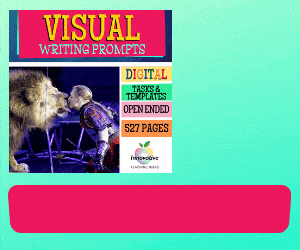
The phrase 'elements of literature' refers to the constituent parts of a work of literature in whatever class it takes: poetry, prose, or drama.
Why are they of import?
Information technology'south important students sympathise these mutual elements if they are to competently read or write a piece of literature.
Agreement the various elements is particularly useful when studying longer works. It enables students to examine specific aspects of the piece of work in isolation, before piecing these separate aspects back together to display an understanding of the work as a whole.
Having a firm grasp on how the different elements piece of work can besides be very useful when comparison and contrasting two or more texts.
Non just does understanding the various elements of literature help us to answer literature analysis questions in exam situations, just it also helps united states of america develop a deeper appreciation of literature in general.
WHAT ARE THE ELEMENTS OF LITERATURE?
This article will examine the following elements: plot, setting, character, point-of-view, theme, and tone.
Each of these wide elements has many possible subcategories and there is, of course, some crossover betwixt some of the elements – this isn't Math, afterward all!
There are hundreds of terms associated with literature as a whole, and I would recommend viewing this glossary for a consummate breakup of these.
WHAT IS THE Deviation BETWEEN AN ELEMENT OF LITERATURE AND A LITERARY DEVICE?
Elements of literature are present in every literary text. They are the essential ingredients required to create any piece of literature, including poems, plays, novels, curt stories, feature manufactures, nonfiction books, etc.
Literary devices, on the other hand, are tools and techniques that are used to create specific effects within a work. Call back metaphor, simile, hyperbole, foreshadowing, etc. Nosotros examine literary devices in detail in other articles on this site.
While the elements of literature will announced in every literary text, non every literary device will.
Now, let's wait at each of these oh-so-crucial elements of literature.
A COMPLETE UNIT ON STORY ELEMENTS
☀️This HUGE resources provides you with all the TOOLS, RESOURCES, and CONTENT to teach students all nigh characters.
⭐75+ PAGES of INTERACTIVE READING, WRITING and COMPREHENSION content and NO PREPARATION REQUIRED.
1: PLOT

Plot refers to all related things that happen in sequence in a story. The shape of the plot comes from the order of these events and consists of several distinct aspects that we'll wait at in plough.
The plot is fabricated up of a series of cause and effect events that atomic number 82 the reader from the beginning of the story, through the middle, to the story's ending (though sometimes the chronological gild is played with for dramatic effect).
Exposition: This is the introduction of the story. Usually, it will be where the reader acquires the necessary background data they'll demand to follow the various threads of the plot through to the end. This is also where the setting of the story is established, the primary characters are introduced to the reader, and the central conflict begins to sally.
Disharmonize: The conflict of the story serves equally the focus and driving force of most of the story's action. Essentially, conflict consists of a central (and sometimes secondary) trouble. Without a problem or conflict, at that place is no story. Conflict commonly takes the form of two opposing forces. These tin be external forces or, sometimes, these opposing forces can take the form of an internal struggle within the protagonist or primary grapheme.
Rise Action: The ascension activeness of the narrative begins at the cease of the exposition. It usually forms most of the plot and begins with an inciting incident that kick-starts a series of cause and effect events. The rising activeness builds on tension and culminates in the climax.
Climax: After the introduction of the problem or central conflict of the story, the action rises as the drama of the story unfolds in a serial of causes and effects. These events culminate in the story'southward dramatic loftier point, known as the climax. This is when the tension finally reaches its breaking bespeak
Falling Activeness: This part of the narrative is made upwards of the events that happen afterward the climax. Things begin to slow downward and work their way towards the story'southward end, tying up loose ends on the way. We can remember of the falling activity equally a de-escalation of the story'due south drama.
Resolution: This is the concluding function of the plot arc and represents the closing of the conflict and the return of normality – or a new normality – in the wake of the story's events. Oftentimes, this takes the course of a significant change inside the primary character. A resolution restores balance and order to the globe or it brings about a new balance and society.
Practise Activeness: PLOT
Hash out a well-known story in class. Fairytales are an first-class resources for this activity. Students must name a scene from each story that corresponds to each of the sections of the plot as listed to a higher place: exposition, disharmonize, rising activity, climax, falling action, and resolution.
2: SETTING

Setting consists of two key elements: space and time. Space refers to the where of the story; well-nigh oft the geographical location where the action of the story takes place. Time refers to the when of the story. This could be a historical period, the nowadays, or the time to come.
The setting has some other aspects for the reader or writer to consider too. For example, drilling down from the broader time and place, elements such as the weather, cultural context, and physical surroundings, etc can exist important.
The setting is a crucial part of a story'due south exposition and is often used to establish the mood of the story. A advisedly crafted setting tin can be used to skillfully hint at the story's theme and to reveal some aspects of the various characters.
Exercise ACTIVITY: SETTING
Get together upward a variety of fiction and nonfiction texts. Students should go through the selected texts and write two sentences about each that identify the settings of each. The sentences should make articulate where and when the stories take place.
3. CHARACTER
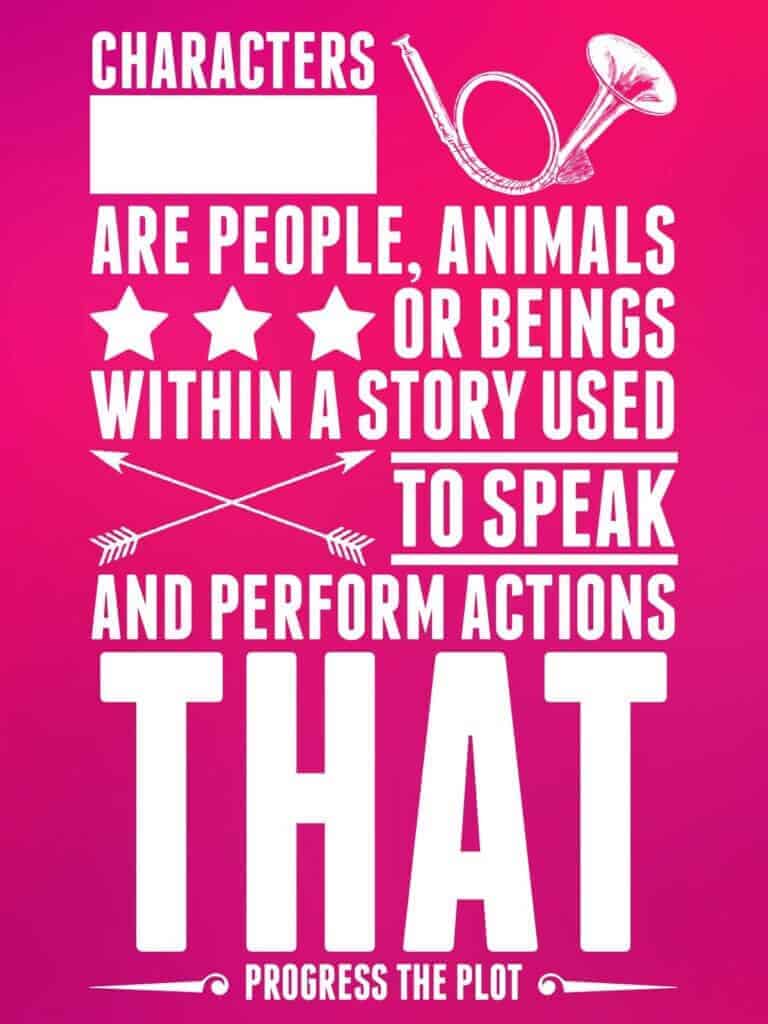
A story's characters are the doers of the actions. Characters about oft take human being course but, on occasion, a story can utilize animals, fantastical creatures, and even inanimate objects as characters.
Some characters are dynamic and alter over the course of a story, while others are static and do not grow or change as a result of the action of the story.
In that location are many different types of characters to exist found in works of literature and each serves a different part.
Now, let's accept a look at some of the most important of these.
Protagonist
The protagonist is the story's main character. The story's plot centers around these characters and they are normally sympathetic and likable to the reader, that is, they are most often the 'hero' of the story.
Antagonist
The antagonist is the bad guy or girl of the piece. Most of the activity of the plot is borne of the conflict betwixt the protagonist and the antagonist.
Flat Character
Apartment characters are one-dimensional characters that are purely functional in the story. They are more than a sketch than a detailed portrait and they help movement the activity forth past serving a simple purpose. We aren't afforded much of an insight into the interior lives of such characters.
Rounded Character
Unlike apartment characters, rounded characters are more circuitous and drawn in more detail by the writer. Also as beingness described in comprehensive physical detail, nosotros will proceeds an insight into the grapheme'south interior life, their hopes, fears, dreams, and desires, etc.
PRACTICE ACTIVITY: SETTING
Choose a play that has been studied in form. Students should look at the character list and then categorize each of the characters according to the types listed above: protagonist, antagonist, flat character, or rounded character. As an extension, can the students identify whether each graphic symbol is dynamic or static past the end of the tale?

four: Signal OF VIEW
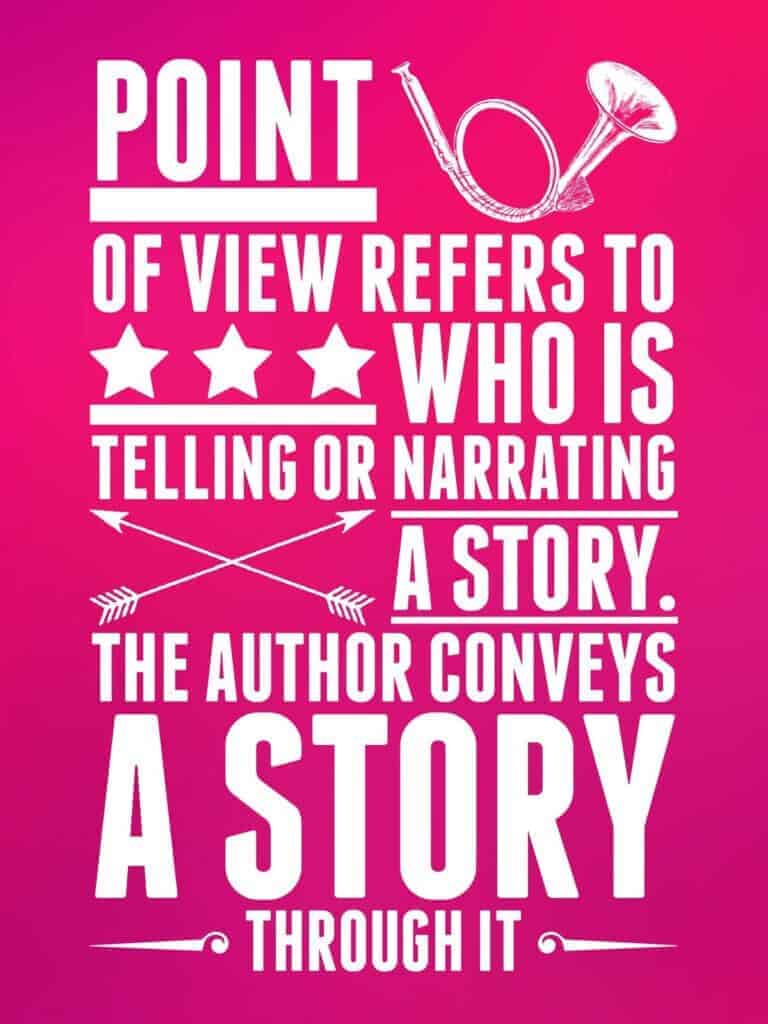
Point of view in literature refers to the perspective through which you experience the events of the story.
At that place are various advantages and disadvantages to the unlike points of view available for the writer to cull from, but they tin can all be usefully categorized according to whether they're first person, second person, or third-person points of view.
Now, let's take a look at some of the nigh common points of view in each of these categories.
First Person
The fundamental to recognizing this point of view lies in the use of pronouns such equally I, me, my, we, united states, our, etc. There are several different variations of the first-person narrative, but they all accept a single person narrating the events of the story either as information technology unfolds, or in the by tense.
When because a showtime-person narrative, the first question to enquire is who is the person telling the story. Let's have a wait at two principal types of the first-person point of view.
First Person Protagonist: This is when the main character of the story relates the activeness first-manus as he or she experiences or experienced it. Every bit the narrator is also the principal character, the reader is placed correct at the center of the activity and sees events unfold through the master character'due south own optics.
First Person Periphery: In this case, we see the story unfold, not from the main grapheme's POV, just from the perspective of a secondary character who has limited participation in the story itself.
Second Person: This perspective is uncommon. Though it is difficult to pull off without sounding corny, you volition observe it in some books such as those Choose Your Ain Take chances type books. You can recognize this perspective through the apply of the 2nd person pronoun 'you'.
Third Person Limited: From this perspective, we run into events unfold from the point of view of one person in the story. As the proper noun suggests, we are limited to seeing things from the perspective of the third person narrator and do not proceeds insight into the internal life of the other characters, other than through their actions every bit described past the tertiary-person narrator (he, she, they, etc).
Tertiary Person Omniscient: The great centre in the sky! The tertiary person omniscient narrator, every bit the name suggests, knows everything about anybody. From this signal of view, nothing is off-limits. This allows the reader to peek behind every pall and into every corner of what is going on as the narrator moves freely through fourth dimension and space, jumping in and out of the characters' heads along the way.
Advantages and Disadvantages
As we've mentioned in that location are specific advantages and disadvantages to each of the dissimilar points of view. While the third person omniscient indicate of view allows the reader full access to each graphic symbol, the third-person express point of view is not bad for building tension in a story every bit the writer can control what the reader knows and when they know it.
The main reward of the offset-person perspective is that it puts the reader into the head of the narrator. This brings a sense of intimacy and personal detail to the story.
We accept a complete guide to point of view here for further details.
Exercise ACTIVITY: Indicate OF VIEW
Take a scene from a story or a movie that the student is very familiar with (once more, fairytales can serve well here). Students must rewrite the scene from each of the dissimilar POV listed above: start-person protagonist, outset-person periphery, second-person, tertiary-person limited, and third-person all-seeing. Finally, discuss the advantages and disadvantages of writing the scene from each POV. Which works best and why?
THE STORY TELLERS BUNDLE OF Education RESOURCES
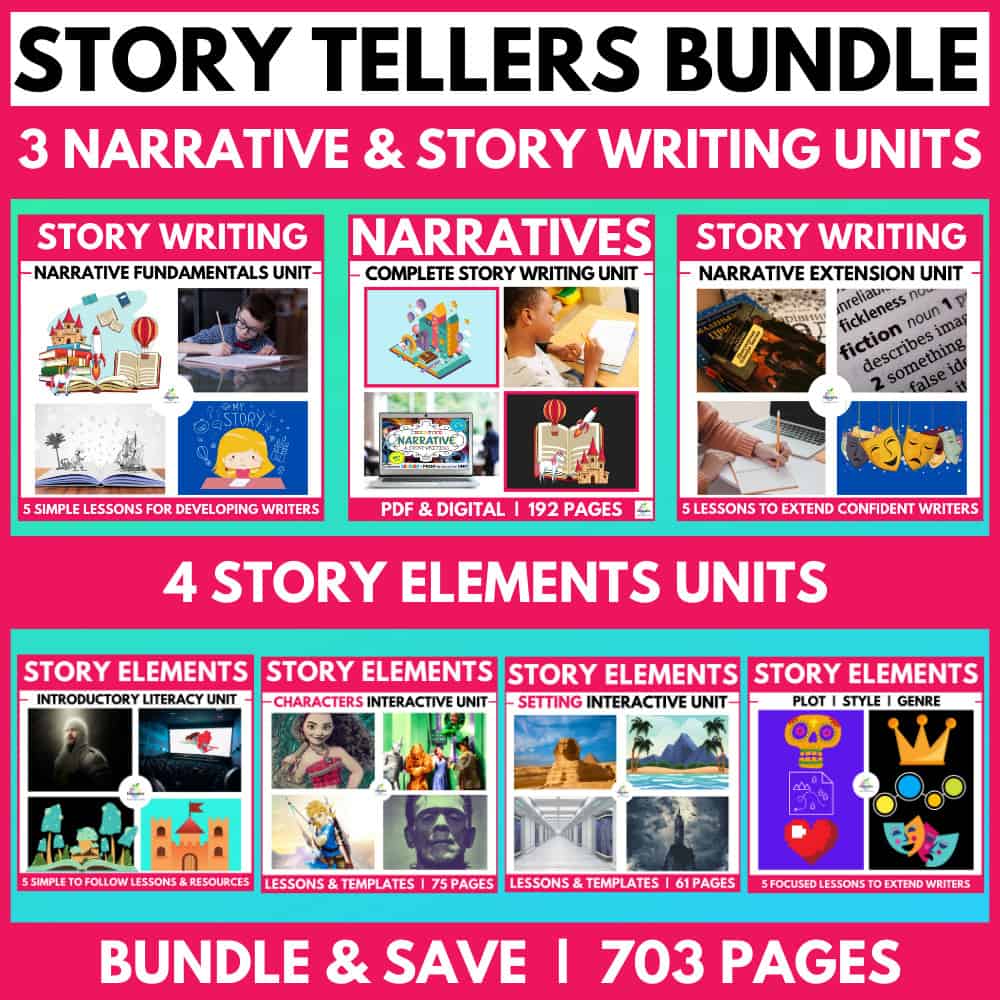
A MASSIVE COLLECTION of resources for narratives and story writing in the classroom covering all elements of crafting amazing stories. MONTHS WORTH OF WRITING LESSONS AND RESOURCES including:
5: THEME
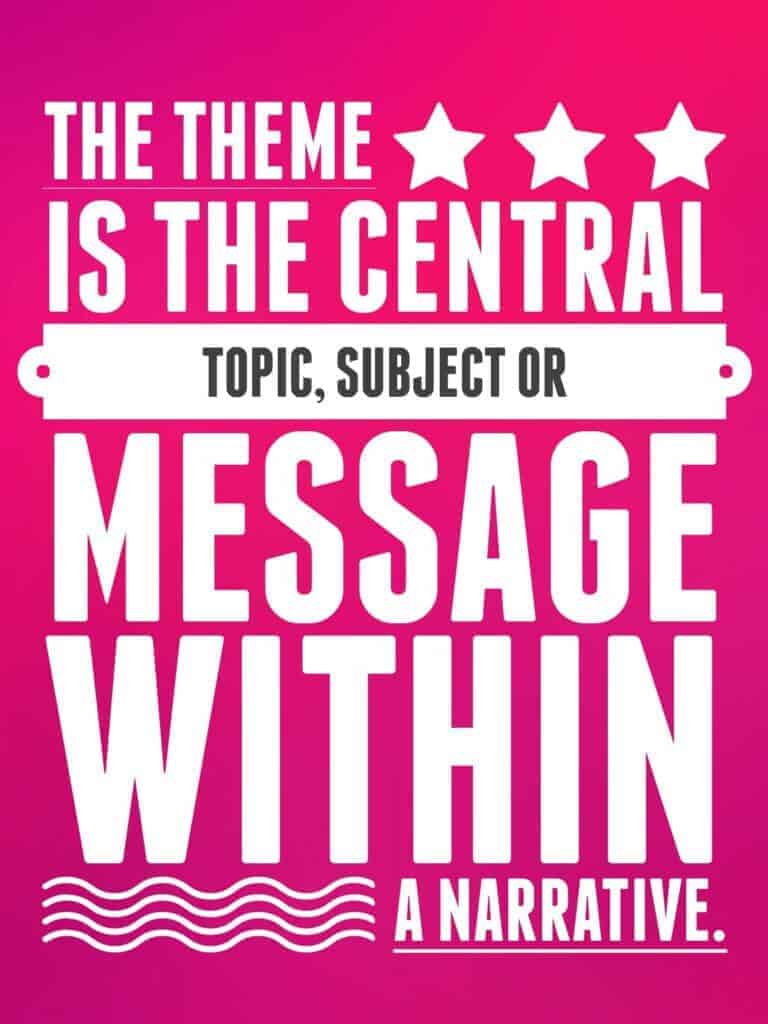
If the plot refers to what happens in a story, then the theme is to exercise with what these events mean.
The theme is the big ideas that are explored in a work of literature. These are most oft universal ideas that transcend the limits of culture, ethnicity, or language. The theme is the deeper meaning backside the events of the story.
Importantly, the theme of a piece of writing is not to exist confused with its subject. While the subject of a text is what information technology is about, the theme is more to exercise with how the writer feels most that subject every bit conveyed in the writing.
It is likewise important to notation that while all works of literature accept a theme, they never state that theme explicitly. Although many works of literature deal with more one theme, information technology's usually possible to observe a primary theme among the minor ones.
The most commonly asked question about themes from students is 'How do nosotros work out what the theme is?'
The truth is, how piece of cake or how difficult information technology will be to observe a work'due south theme will vary profoundly between different texts. The ease of identification will depend largely on how straightforward or how circuitous the work is.
To identify the theme, students should wait out for symbols and motifs within the text. Especially symbols and motifs that echo.
Students further need to understand that symbols are when one thing is used to stand for another. While not all symbols are related to the theme of the text, when symbols are used repeatedly or found in a cluster, they usually relate to a motif. This motif will in turn relate to the theme of the work.
Of course, this leads to the question: What exactly is a motif?
A motif is a recurring idea or an element that has symbolic significance. Uncovering this significance will reveal the theme to a careful reader.
Nosotros can further sympathize the themes as concepts and statements. Concepts are the wide categories or issues of the piece of work, while statements are the position the author takes on those problems every bit expressed in the text.
Here are some examples of thematic concepts commonly plant in literature:
- Love
- Revenge
- Justice
- Betrayal
- Jealousy
- Forgiveness
When discussing the theme of a work in whatever detail, identifying the thematic concept volition not exist enough. Students will need to explore what the thematic statements are in the text. That is, they need to identify the opinions the writer expresses on the thematic concepts in the text.
For case, nosotros might identify that a story is about forgiveness, that is, that forgiveness is the primary thematic concept. When we place what the work says most forgiveness, such every bit forgiveness is necessary for a person to move on with their life, nosotros are identifying a thematic statement.
Exercise ACTIVITY: THEME
Once again, choose familiar stories to work with. For each story place and write down both the thematic concept and the thematic statement. For more than complex stories, in that location may be multiple themes that need to exist identified.
AN EXCELLENT VIDEO TUTORIAL ON STORY ELEMENTS
6: TONE

Tone refers to how the theme is treated in a piece of work. Two works may have the same theme, only each may adopt a dissimilar tone in dealing with that theme. For example, the tone of a text tin be serious, comical, formal, informal, gloomy, joyful, sarcastic, or sentimental, to proper name but eight.
The tone that the writer adopts influences how the reader reads that text. It informs how the reader will feel almost the characters and events described.
Tone helps to create the mood of the piece and gives life to the story equally a whole.
Practise ACTIVITY: TONE
Find examples of texts that convey each of the eight tones listed higher up: serious, comical, formal, breezy, gloomy, joyful, sarcastic, and sentimental. Requite 3 examples from each text that convey that specific tone. The examples tin can be fatigued from directly quotations of the narrative or dialogue, or from a commentary on the construction of the text.
Conclusion:
Though the essential elements of literature are few in number, they can take a lifetime to principal. The more experience a student gains in creating and analyzing texts with reference to these elements, the more than good they will become in their use.
Time invested in this area will reap rich rewards in terms of the skill with which a student can craft a text and also in the level of enjoyment and meaning they can derive from their reading.
Fourth dimension well spent, for certain.

OTHER GREAT Articles RELATED TO ELEMENTS OF LITERATURE

7 ways to write not bad Characters and Settings | Story Elements
STORY ELEMENTS: How to Write Peachy Characters and Settings You can't have a good story without the characters to do things and places for them to do those things in. In this commodity, we're talking about bang-up characters and settings and how to write them. Characters and setting are two key ingredients that form the…
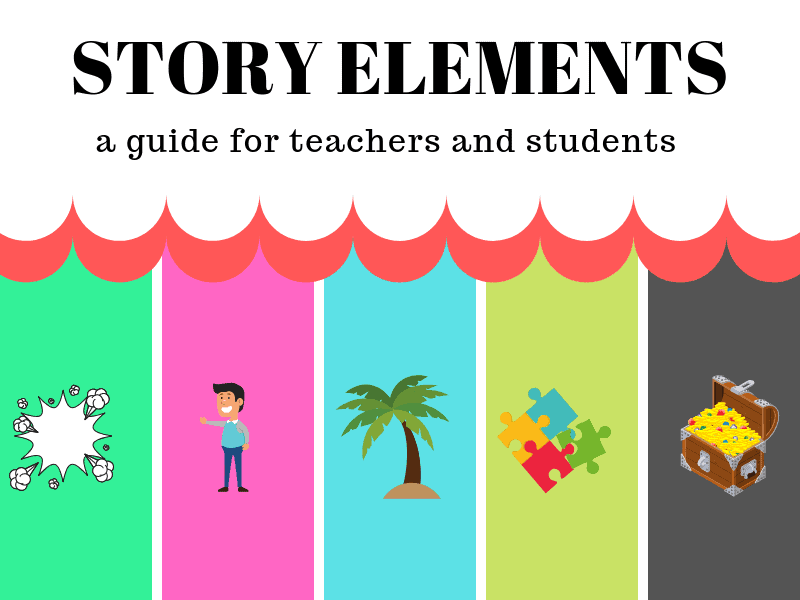
Didactics The v Story Elements: A Complete Guide for Teachers & Students
What Are Story Elements? Developing a solid understanding of the elements of a story is essential for our students to follow and fully comprehend the stories they read. However, before students can empathize how these elements contribute to the overall meaning and effect of a story, they must beginning be able to identify the component…
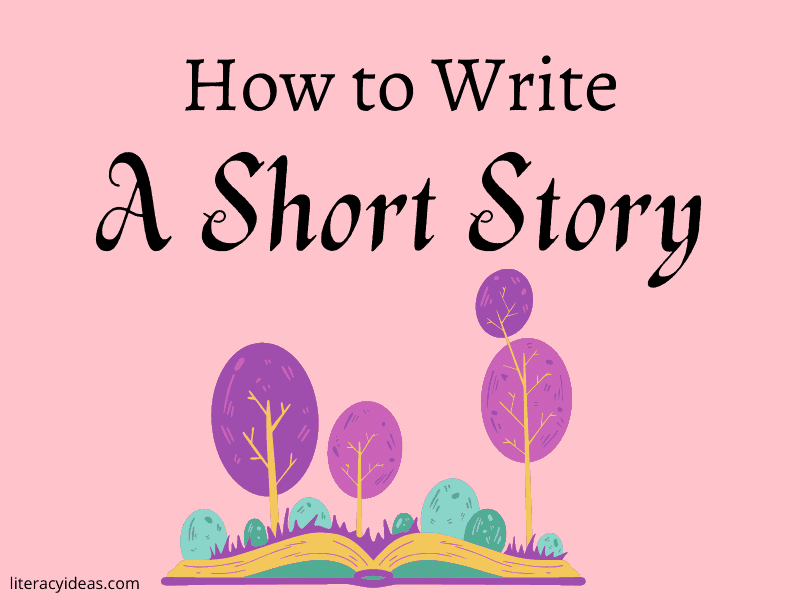
Short Story Writing for Students and Teachers
What Is a Brusque Story? The clue is in the title! Curt stories are like novels only…well…shorter! They incorporate all the crucial elements of fully adult stories except on a smaller scale. In short story writing, yous'll find the key story elements such every bit characterization, plot development, themes explored, etc, but all within a discussion…
The content for this page has been written by Shane Mac Donnchaidh. A sometime primary of an international schoolhouse and academy English lecturer with xv years of teaching and administration feel. Shane's latest Book the Complete Guide to Nonfiction Writing tin be found here. Editing and support for this article take been provided by the literacyideas team.
montgomerywhimpaincy.blogspot.com
Source: https://literacyideas.com/elements-of-literature/
0 Response to "What Is a Big Idea That Shows Up Again and Again in Literature of All Time Periods"
Post a Comment